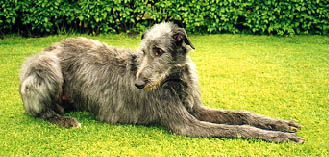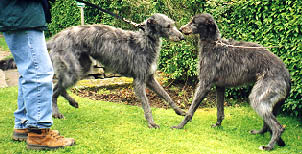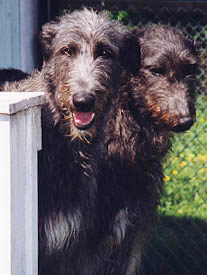 |
|---|
|
Visually, the Scottish Deerhound can be likened to a large, strong boned Greyhound with a very rough hair coat. Just a little stronger built, this "gentle giant", (because as pets around the house, they are quiet, sweet and loving, good with children and looking and acting as if butter wouldn't melt in their mouths), has been bred for running down and killing the large and fearsome stags that still abound in Scotland to this day. They are built for hard work, running up and down steep mountain sides in rough, stony terrain, often in cold, bad weather snow and sleet. Hence the touch rough haired coat. A practiced Deerhound knows how to chase, run alongside and then to leap up and take a hold of a running deer by the throat pulling it off balance and bringing it down at full speed. A heavy stag most often breaks its neck. This seems wild, but you would never guess to look at them. My thanks to Amelia Brock, Denmark, for all the lovely photos of her Swedish bred dog and best friend "Kamante"! |
| THE SCOTTISH DEER HOUND Deerhounds are one of the few breeds that have changed very little in the last few hundred years. Anyone who reads old history books will find references to: "Rough or wire haired Greyhound", "Irish Greyhound", "Scottish Greyhound", "Scottish Deerhound", "Highland Deerhound" and many other variations of the name. Alone it's appearance conjures up visions of the Scottish Highland's mountainous and rugged landscape dotted with villages, castles, heather clad hillsides, and of course the magnificent stags. With this backcloth, one can easily visualize a deerhound with it's strong feet placed firmly, standing well balanced on a rough stony mountainside, while the gusty windy blows its eyebrows back revealing dark eyes burning with tension and excitement. Its dense and tufted wirehair coat a perfect protection against the wind and rain. HISTORY |
 In the beginning of the 19th century, the breed was down to only a few dozen. However, Deerhounds succeeded in doing a "come back" at the end of the Napolionic wars in 1815 which brought a period of peace. Those officers who came home again saught a more exciting sport and found tracking down the deer much more to their taste. The owners of the many smaller forrest areas made a great living from renting them out to all the "well off" hunters and hunting sport supporters. |
| EARLY BREEDERS The oldest breed of Deerhounds is probably "Chesterhill", established by Menzies in the beginning of the 19 th century. Others were Morrison of Glenelg, M'niel of Colonsay and Bateson of Combusmere. The latter owned many of the models used by painter Edwin Landseers pictured in many famous paintings, because he reckoned them to be the finest examples of the breed he ever had seen.
But, alas, fate was again against the Deerhounds and their coursing form, as many now fell victim to the illness "distemper" which ended the life of many a good dog. However, yet again luck turned and in the south of England, a certain Major James Robertson managed to preserve the bloodlines from his uncle Colonel David Ross. Amongst other breeders was the poet Sidney Dobell, Captain Graham of Dursley, (later re-creater of the Irish Wolfhound as we know it today, only at this moment in time he was devoted to the cause of the Deerhound), Mr. Wright-Osmaston in Derbyshire, Mr. Barr of Manchester, Mr. Hickman in London and Mr. Parsons in Nottingham. We owe these breeders a great deal for their hard work in preserving the breed |
THE PREY The Deerhounds natural prey is of course the stag, but unfortunately or luckily - depending on how you look at it, it is not permitted to hunt them any more. The deer are more than 130 cm high at the shoulders and weigh over 125 kilos. They are incredibly fast and strong and a deerhound must also be very fast and strong to overtake and bring it down by leaping up and biting at the neck, thereby bringing it down and often breaking it's neck in the fall. Not only this but the stags have the most impressive defense: the antlers. Although they bear these with an aristocratic arrogance, they are not merely for decoration but extremely dangerous weapons against all rivals and enemies. Many a deerhound has felt these in its body and how effectively they can be used! COURSING |
| PRESENT DAY BREEDERS Without a doubt, the largest kennels with the greatest influence on the breed has been Miss Norah Hartley's "Rotherwood" Kennel and Miss Anastasia Noble's "Ardkinglas" Kennel. Miss Hartley began her dog career with an open mind, wanting to choose whatever dog that was "right" for her. One requirement was, that she could hold the collar without having to bend down! She also wanted a breed with beautiful elegant lines and agile active movement. But most of all, she wanted a breed that had an open, loving mind which one could trust through and through. There must be no nervousness, lack of trustworthiness or any aggressiveness. All these qualities are found in Deerhounds! A friend lent her a book on all dog breeds and Deerhounds kept on coming to the top of her list. Her father loved the poetry and novels of Sir Walter Scott, and said that if she was to own dogs and breed from them, then it would be lovely to have the same breed as Sir Walter Scot wrote so much about. One like Scott's much loved Deerhound called "Maida". Her father also took her to the big dog show held at Alexandra Palace in London in 1925, and they both were very attracted to the Deerhounds they saw there. Since then, Deerhounds have been the one and only breed in her life. Through the years there have been 35 Rotherwood Champions and all from her own breeding. Paula of Rotherwood, born in 1948, wasn't in herself particularly excellent but she proved to be the most reliable and excellent brood bitch. She still holds the record of having produced the most Champions, 6 in all. THE PRESENT |
Those who are new in the breed and who want to show their dog should remember the natural "tousled" look which was no doubt partly what first attracted them to the breed. Deerhounds do not need the enormous amount of combing and brushing that many other breeds with long coats have do. Just a quick brush through before going in the ring is enough. Also, they should never be dragged around "strung up" on the lead like many other breeds, but shown as naturally as possible. Keep the "natural look" all the way, as that probably was what attracted you in the first place! Deerhounds are Sighthounds and so have the Sighthound's catlike nature. They can be independent, disobedient and also suddenly stone deaf when it suits them, but having said that, one also should add that they are one of the "easiest" to have and to train of all the Sighthounds. Since they don't ALWAYS do what you say, but often "think for themselves", if you are the type who wants total obedience at all times and a well trained obedient dog willing to carry out your every order - well then you had best not choose a Deerhound! Deerhounds have their own ideas and opinions about things and are perfectly willing do just as you want them to, IF they think that its amusing or something they like. It's up to you to make training as interesting and fun as possible They are very "fine feeling" and sensitive dogs that only need a short firm reprimand as punishment for any "naughtynesses", never physical punishment and it's no good loosing your temper for hours either. Hot tempered people will only get an unnaturally nervous and frightened Deerhound as a result. Large breeds such as the Deerhound are slow to mature and it is especially important to take care with not only a good diet to ensure optimal bone growth together with good exercise to give a well developed physique, but also to train them mentally and let them have many varied and good experiences and get to know all about the world they are living in, from earliest puppyhood. Deerhounds do not smell unpleasantly of "dog" and their coat is very easy to keep clean in the daily run. Deerhounds love their families and are happiest living together with them in close contact. They are good with children of all ages - though of course all children must be taught to show proper respect for any dog breed. Deerhounds may look big, but is amazing how small they can be when curled up and often manage to squeeze into any dog bed or car seat etc. Once a Deerhound lover, always a Deerhound lover! Written by Joan P. Garth, Germany 1994. My e-mail: janetfm@sighthound.net |
